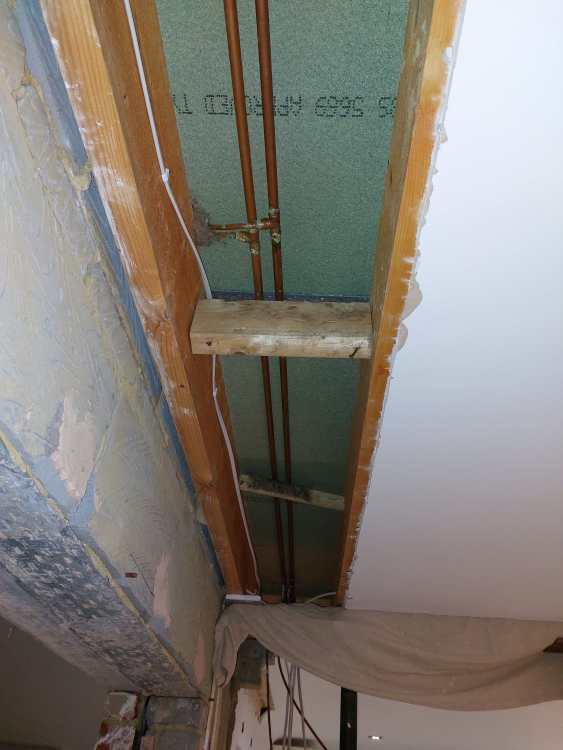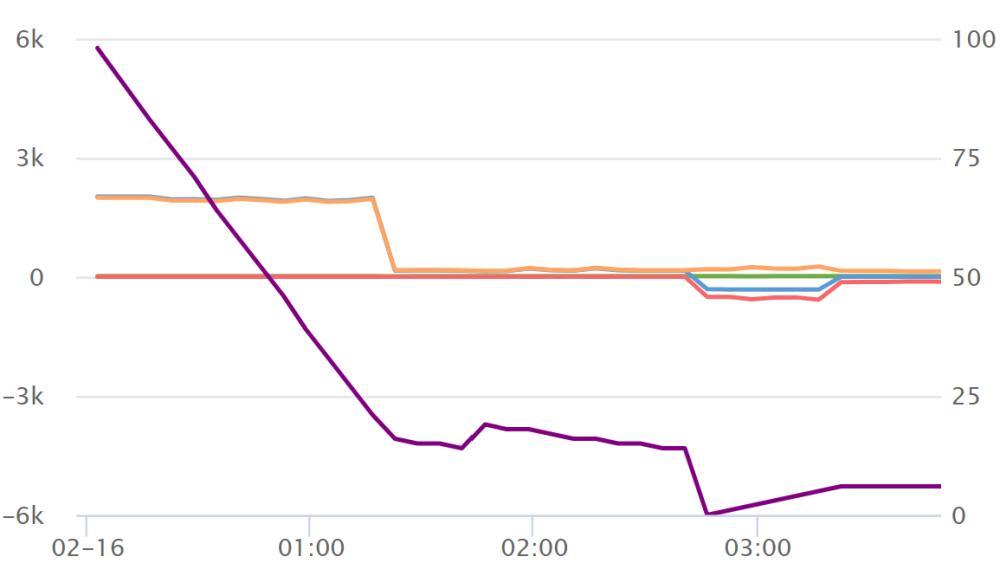
PhilT
Members-
Posts
494 -
Joined
-
Last visited
Everything posted by PhilT
-
Ecodan Fixed Flow Mode - Exceeding Flow Temp Setting
PhilT replied to BadgerBadger's topic in Air Source Heat Pumps (ASHP)
possibly the heat pump's minimum modulation level cannot get that low? What happens if you set it to 27? -
30 Year Old 8mm Microbore Circuit Changes
PhilT replied to PhilT's topic in Central Heating (Radiators)
Certainly worth considering now I know the top floor is mostly 15mm -
The figures vary a lot by manufacturer for example, at 35C the 10kW Vaillant Arotherm Plus SCOP is 5.03 vs the 7kW model at 4.36 (MCS test results). But my calcs look at this in a different way, by comparing an 11.2kW heat pump running comfortably within it's so-called "mid-range" capacity (c. 9kW ball park) vs the equivalent 8.5kW running flat out, at different ambient temps. So an over-sized heat pump could be more efficient or, at worst, no less efficient than the "perfect size" (for want of a better description).
-
Looking to upgrade to 15mm. I thought the 8mm microbore circuit was fed by manifolds, but removing the downstairs ceiling reveals instead a 15mm secondary circuit feeding short 8mm microbore feeds to the upstairs rads, and long 8mm microbore runs dropping down to the ground floor rads (see photo). This should make things easier because I won't have to hunt around for the manifolds, I can just leave the upstairs rad circuit as it is, run two new 22mm pipes dropping down from the primary circuit upstairs, just after the secondary circuit pump in the airing cupboard, and then connect new 15mm runs from the two central 22mm drop downs to the downstairs rads. Any issues with that approach?
-
The output ranges in that data table aren't exactly like for like, but it indicates that the larger unit is more efficient across the whole range of ambient temps, so a more cautious approach in selecting the 'next size up' should not significantly compromise efficiency and running costs.
-
It would seem that for modern scroll compressors, for a given range of output, a larger compressor is more efficient than a smaller one across the entire ambient temperature range. This is the Ecodan data table. The Vallant Arotherm+ shows a similar pattern when comparing the 10kW and 12kW to the 7kW model. Up front cost is obviously a consideration. 11.2 "Mid range " vs 8.5 "Max" @ 35°C In kW In kW Out kW Out kW COP COP 11.2 kW 8.5 kW 11.2 kW 8.5 kW 11.2 kW 8.5 kW % dIff. outside temp °C -15 2.7 3.4 6.7 7.3 2.5 2.15 16% -10 2.9 3.7 8.1 8.5 2.8 2.3 22% -7 3.0 3.6 9 8.8 3.05 2.45 24% 2 2.4 3.0 9 9.7 3.75 3.2 17% 7 1.9 2.3 9 10.5 4.8 4.55 5% 12 1.4 2.3 9 10.7 6.25 4.6 36% 15 1.3 2.3 9 11.5 7.05 4.9 44%
-
the counter argument is that at the coldest temps, for a given heat output, an oversized heat pump works more efficiently than undersized - manufacturer's data tables back that up. During the coldest days you could be using 10 x as much electricity as the mildest heating days. Think about the maths, for example, 10% more efficiency x 100kWh on the coldest days = a 10kWh saving, whereas 10% inefficiency x 10kWh on the mildest days means only a 1kWh loss.
-
Ecodan PUZ-WM112VAA requires a software update.
PhilT replied to Vinz86's topic in Air Source Heat Pumps (ASHP)
Mitsubishi sent someone out to do mine for no charge to update to the firmware via the outside unit. It has made a significant difference especially in October, much longer runs at lower temp/power consumption and better control of room temp around the target. I'm running in full auto (room temp) mode using the Mitsubishi room controller. -
could be - the specs say it has "low temperature protection", but that's a very short warming time and it happens every single discharge irrespective of temperature
-
At around 02:40, with consumption (orange) continuing at a background level, there is an unscheduled light battery charge (blue and red lines) but, bizarrely, in the first 5 minutes, the SOC (purple line) drops from around 17% to ZERO, WITHOUT ANY CORRESPONDING CHANGE IN CONSUMPTION OR OTHER OUTGOING POWER, then gradually goes up to around 6% SOC at around 03:20 at the end of this mysterious little charge cycle
-
Every time my battery charges and discharges, even though the minimum discharge level is set to 6%, it always overrides that and discharges to zero then recharges to 6%. Anyone know why that happens?
-
Are we targeting ASHP's at the wrong market?
PhilT replied to ProDave's topic in Air Source Heat Pumps (ASHP)
Gas plant efficiency is far worse than theoretical because of renewables fluctuations -
Surely it's similar to the English scheme whereby you can apply for the 7500 grant for a self build if it meets certain criteria
-
BUS Grant requirements (conflicting info)
PhilT replied to Rudski's topic in Air Source Heat Pumps (ASHP)
-
Going away soon. For a week's holiday at this time of year, how do people set their heat pump modes, temps and timings, and with what objectives in mind?
-
Are we targeting ASHP's at the wrong market?
PhilT replied to ProDave's topic in Air Source Heat Pumps (ASHP)
Agreed where we are talking about replacing a perfectly good boiler system. But if it's 30+ years old like mine was, and needs a major upgrade anyway, the net cost to me of a new ASHP, DHW tank and bigger rads was no different to a modern upgraded boiler system. That financial equation of course varies enormously from the cheapest (possibly one of the utility companies like Octopus) to the most expensive (premium expert installers such as Heat Geek) -
Are we targeting ASHP's at the wrong market?
PhilT replied to ProDave's topic in Air Source Heat Pumps (ASHP)
and an oversize heatpump like mine working 10% more efficiently than a smaller one running flat out/less efficiently on freezing cold days will mean 10% less electricity use at the time when the grid may be well over-stretched. I don't understand why people would burden themselves with additional expense and complexity of adding heating elements, boiler hybrid setups etc. when all you need is a bigger heat pump. Imagine a family during the recent freezing cold spell, they all come down with flu or lurgy of some kind (very likely this season). The house temp needs to be increased a couple of degrees all day and night to give them all the chance to get well again. In those circumstances you need a level of headroom similar to what you got from a boiler. This is just one of the many advantages of an oversized heat pump - extension, faster DHW reheat, less defrost recovery issues etc. etc. -
Are we targeting ASHP's at the wrong market?
PhilT replied to ProDave's topic in Air Source Heat Pumps (ASHP)
Modern scroll compressor / clever software controlled heat pumps just don't suffer the cycling inefficiences of the bad old days. For me there was no difference in installation price between an 8.5 and an 11 so I went for the 11 and glad I did. It is outperforming spec on cold days by a significant margin. Compare 10% inefficiency on a mild day of say 10kWh consumption compared to 10% better efficiency on a cold day of 100kWh consumption. It's unlikely to be worse than break even over the course of the season. That's definitely what the evidence is saying for mine. -
Are we targeting ASHP's at the wrong market?
PhilT replied to ProDave's topic in Air Source Heat Pumps (ASHP)
why exactly? -
Are we targeting ASHP's at the wrong market?
PhilT replied to ProDave's topic in Air Source Heat Pumps (ASHP)
why not just get a bigger heat pump -
what's the problem with it being a little louder than whisper quiet for relatively tiny periods of time. The compressor on mine after defrost is barely audible, and I'm sure it's no quieter than the Vaillant
-
Are we targeting ASHP's at the wrong market?
PhilT replied to ProDave's topic in Air Source Heat Pumps (ASHP)
To an extent, yes, but maybe not as much as people believe Green levies are 6% of a typical gas bill, 16% of an electricity bill, and 11% of the average dual fuel bill. Climate change levy rate for gas is 0.672 pence per kWh, while the rate for electricity is 0.775 pence per kWh. -
Are we targeting ASHP's at the wrong market?
PhilT replied to ProDave's topic in Air Source Heat Pumps (ASHP)
I got my info from here https://www.theecoexperts.co.uk/news/green-levy#:~:text=The green levy is a,or should it be scrapped? but as you imply other sources have a different take, whatever, the point is it's on gas


